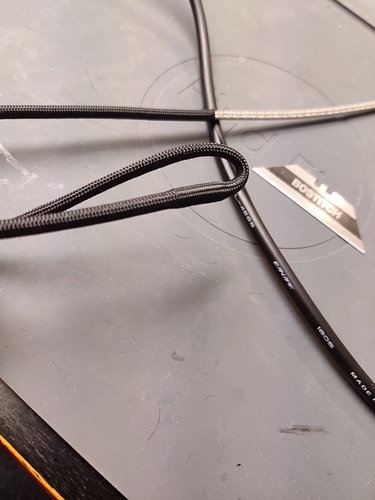It’s impossible to say without comparing specific cables.
There’s no general rule that applies here as to whether 4 or 8 conductors is better excepting that, all other things being equal, an 8 conductor cable would have:
- Lower resistance
- Higher capacitance
- Less flexibility
- Higher weight
- Higher cost
Three primary variables are at work with the wire part of a cable:
-
Resistance - affected by conductor material and gauge (thickness)
-
Capacitance - affected by conductor materials and effective surface area
-
Geometry - affected by the braiding or winding of wires and the internal structure of individual conductors
Resistance (Lower is Better):
Lower gauge (fatter wire) has less resistance:
If you had a 4-conductor cable, that’s one conductor per phase (+/-) per channel. If the conductor itself was 24 gauge, then all other things being equal an 8-conductor cable (two conductors per phase/per channel) would have half the resistance of the 4-conductor version. If the 8-conductor cable was made using 26 gauge cable, which is thinner and more flexible, then it’d have an effective gauge of 23 and still have less resistance than the 4-conductor cable.
Different metals conduct better/worse:
Some metals conduct better than others. For example, silver has lower resistance than copper, high-purity/OFC copper has lower resistance than normal copper, copper has lower resistance than aluminum etc. The resistance differences here are dwarfed by those resulting from simply using a different thickness of wire.
And bear in mind, in both of the above cases, we’re talking about very low resistance values to begin with. So while lower resistance is BETTER … a typical headphone cable might have 1-2 ohms of total resistance end-to-end. This isn’t particularly relevant with most headphones (it’s a non-issue for anything planar and for anything over about 20 ohms impedance - which is almost every non-IEM transducer available).
Capacitance (Lower is Better):
Capacitance is primarily a function of how much insulated surface area a wire has. If you double the number of insulated conductors, you double the capacitance. If you double the length of a given insulated conductor, you double the capacitance. So, if using the same conductors for both, an 8-conductor cable would have higher capacitance than a 4-conductor cable.
For practical purposes stranded (most headphone wire) and solid-core cables of the same circumference have the same capacitance (since in conventional stranded wires, the individual strands are not insulated from each other and they effectively act like a single conductor at audio frequencies).
True Litz-stranded conductors have all the individual strands in each wire individually insulated, so will generally exhibit higher capacitance (due to a higher insulated surface area) than a single strand of equivalent gauge.
Geometry
This refers to both the internal arrangement of an individual conductor, as well as the overall arrangement of all the conductors. And by “arrangement” I mean how they are wound/twisted/interleaved/braided etc.
In general, this affects how much electrical noise/interference is rejected or attenuated, and what potential for signals for one channel or phase have to effect others.
Straight wire runs have no practical noise rejection. Twisted pairs have some. Star-quad has excellent rejection characteristics. And then adding shielding (assuming it is done properly) can further improve this. A fair amount of precision (usually involving spacers, binders and so on to maintain) is required to make noise-rejecting geometries consistent enough to work, especially as the cable twists or bends.
Some braided cables are done in a manner that effectively gives you one of the above (or other) noise-rejecting geometries. And some have no useful electrical benefit and are more about aesthetics (nothing wrong with that, as long as not claiming otherwise).
From a practical perspective, the signal levels involved in a headphone cable, are too small to have a meaningful level of induced crosstalk. And the value of noise-rejection is rather limited unless you’re in a highly polluted environment or are running cables around/across other gear/cables that ARE carrying lots of power (e.g. lighting packs/controllers). This is rarely the case (especially for home use).
All of the above effects are 100% measurable and well documented (in fact wire/cable is usually sold with specifications for resistance, capacitance - and for cables noise rejection - at different lengths). They become much more relevant with bigger signals, longer cable runs, and higher frequencies.













